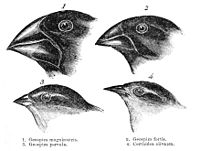
Photo from wikipedia
The genomic proportion that two relatives share identically by descent-their genetic relatedness-can vary depending on the history of recombination and segregation in their pedigree. Previous calculations of the variance of… Click to show full abstract
The genomic proportion that two relatives share identically by descent-their genetic relatedness-can vary depending on the history of recombination and segregation in their pedigree. Previous calculations of the variance of genetic relatedness have defined genetic relatedness as the proportion of total genetic map length (cM) shared by relatives, and have neglected crossover interference and sex differences in recombination. Here, we consider genetic relatedness as the proportion of the total physical genome (bp) shared by relatives, and calculate its variance for general pedigree relationships, making no assumptions about the recombination process. For the relationships of grandparent-grandoffspring and siblings, the variance of genetic relatedness is a simple decreasing function of r¯, the average proportion of locus pairs that recombine in meiosis. For general pedigree relationships, the variance of genetic relatedness is a function of metrics analogous to r¯. Therefore, features of the aggregate recombination process that affect r¯ and analogs also affect variance in genetic relatedness. Such features include the number of chromosomes and heterogeneity in their size, the number of crossovers and their spatial organization along chromosomes, and sex differences in recombination. Our calculations help to explain several recent observations about variance in genetic relatedness, including that it is reduced by crossover interference (which is known to increase r¯). Our methods further allow us to calculate the neutral variance of ancestry among F2s in a hybrid cross, enabling precise statistical inference in F2-based tests for various kinds of selection.
Journal Title: Genetics
Year Published: 2020
Link to full text (if available)
Share on Social Media: Sign Up to like & get
recommendations!